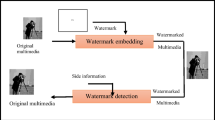Abstract
Digital image watermarking has been witnessed as a powerful tool that can be used in image ownership identification, copyright protection and content authentication applications. In this paper, a dual-domain watermarking scheme for digital image authentication with self-recovery capabilities is proposed. The proposed scheme has a high ability to recover tampered image regions while pertaining high watermarking imperceptibility and high robustness under various types of attacks. The proposed scheme employs two watermarks: 1) content-dependent, and, 2) content-independent, where the content-dependent watermark contains two-bit sequences for authentication and recovery operations. The authentication bits are generated based on the singular value decomposition (SVD) of each block, while the recovery bits are generated from the average value within selected sub-blocks. The independent watermark is embedded using the Discrete Cosine Transform (DCT), whereas, the dependent watermark is embedded directly into the first and second least significant bits (LSB) of the image pixels. The developed dual-domain watermarking scheme has exhibited high robustness performance against various attacks with high imperceptibility and watermarking capacity as well. For authentication purposes, the proposed scheme incorporated three developed measures to detect the authenticity of the probe image, and, to accurately localize tampered regions. The experimental results have shown that the proposed scheme has a high imperceptibility, compared to other existing schemes, and can effectively distinguish malicious from incidental attacks with accurate tampering localization. Moreover, the proposed scheme exhibits high performance against moderate-to-strong incidental attacks such as noise and low-quality JPEG attacks.




















Similar content being viewed by others
References
Barani MJ, Valandar MY, Ayubi P (2019) A new digital image tamper detection algorithm based on integer wavelet transform and secured by encrypted authentication sequence with 3D quantum map. Optik 187:205–222
Begum M, Uddin MS (2020) Digital image watermarking techniques: a review. Information 11(2):110
Dadkhah S, Manaf AA, Hori Y, Hassanien AE, Sadeghi S (2014) An effective svd-based image tampering detection and self-recovery using active watermarking. Signal Process Image Commun 29(10):1197–1210
Durgesh S, Singh SK (2016) Effective self-embedding watermarking scheme for image tampered detection and localization with recovery capability. J Vis Commun Image Represent 38:775–789. https://doi.org/10.1016/j.jvcir.2016.04.023
Ernawan, F., & Kabir, M. N. (2018). A block-based RDWT-SVD image watermarking method using human visual system characteristics. The Visual Computer, 1-19.
Fan MQ, Wang HX (2018) An enhanced fragile watermarking scheme to digital image protection and self-recovery. Signal Process 66:19–29. https://doi.org/10.1016/j.image.2018.04.003
Ghosal SK, Mandal JK (2014) Binomial transform based fragile watermarking for image authentication. Journal of information security and applications 19(4–5):272–281
Hemida, O., & He, H. (2020). A self-recovery watermarking scheme based on block truncation coding and quantum chaos map. Multimedia Tools and Applications, 1-31.
Kalra GS, Talwar R, Sadawarti H (2015) Adaptive digital image watermarking for color images in frequency domain. Multimed Tools Appl 74(17):6849–6869
Lee TY, Lin SD (2008) Dual watermark for image tamper detection and recovery. Pattern Recogn 41(11):3497–3506
Liu XL, Lin CC, Yuan SM (2016) Blind dual watermarking for color images’ authentication and copyright protection. IEEE Transactions on Circuits and Systems for Video Technology 28(5):1047–1055
Lu CS, Liao HY (2001) Multipurpose watermarking for image authentication and protection. IEEE Trans Image Process 10(10):1579–1592
Lusson F, Bailey K, Leeney M, Curran K (2013) A novel approach to digital watermarking, exploiting colour spaces. Signal Process 93(5):1268–1294
Molina-Garcia J, Garcia-Salgado BP, Ponomaryov V, Reyes-Reyes R, Sadovnychiy S, Cruz-Ramos C (2020) An effective fragile watermarking scheme for color image tampering detection and self-recovery. Signal Process Image Commun 81:115725
Nematollahi MA, Vorakulpipat C, Rosales HG (2017) Digital watermarking techniques and trends. Springer
Patra, B. and Patra, J.C., (2012), November. Crt-based fragile self-recovery watermarking scheme for image authentication and recovery. In intelligent signal processing and communications systems (ISPACS), 2012 international symposium on (pp. 430-435). IEEE.
Qi X, Xin X (2015) A singular-value-based semi-fragile watermarking scheme for image content authentication with tamper localization. J Vis Commun Image Represent 30:312–327
Qin C, Ji P, Zhang X, Dong J, Wang J (2017) Fragile image watermarking with pixel-wise recovery based on overlapping embedding strategy. Signal Process 138:280–293
Savakar DG, Ghuli A (2017) Non-blind digital watermarking with enhanced image embedding capacity using Meyer wavelet decomposition, SVD, and DFT. Pattern Recognition and Image Analysis 27(3):511–517
Sikder I, Dhar PK, Shimamura T (2017), February. A semi-fragile watermarking method using slant transform and LU decomposition for image authentication. In Electrical, Computer and Communication Engineering (ECCE), International Conference on (pp. 881-885). IEEE.
Su Q, Chen B (2018) Robust color image watermarking technique in the spatial domain. Soft Comput 22(1):91–106
Tai WL, Liao ZJ (2018) Image self-recovery with watermark self-embedding. Signal Process 65:11–25. https://doi.org/10.1016/j.image.2018.03.011
Tong X, Liu Y, Zhang M, Chen Y (2013) A novel chaos-based fragile watermarking for image tampering detection and self-recovery. Signal Process Image Commun 28(3):301–308
Zhang F, Zhang X (2007) Digital image watermarking capacity and detection error rate. Pattern Recognition Letters 28:1–10. https://doi.org/10.1016/j.patrec.2006.04.020
Zhang X, Qian Z, Ren Y, Feng G (2011) Watermarking with flexible self-recovery quality based on compressive sensing and compositive reconstruction. IEEE Transactions on Information Forensics and Security 6(4):1223–1232
Author information
Authors and Affiliations
Corresponding author
Ethics declarations
Conflict of interest
Author (Hazem Munawer Al-Otum) declares that he has no conflict of interest.
Author (Mouaz Ibrahim) declares that he has no conflict of interest.
Additional information
Publisher’s note
Springer Nature remains neutral with regard to jurisdictional claims in published maps and institutional affiliations.
Rights and permissions
About this article
Cite this article
Al-Otum, H.M., Ibrahim, M. Color image watermarking for content authentication and self-restoration applications based on a dual-domain approach. Multimed Tools Appl 80, 11739–11764 (2021). https://doi.org/10.1007/s11042-020-10368-9
Received:
Revised:
Accepted:
Published:
Issue Date:
DOI: https://doi.org/10.1007/s11042-020-10368-9




